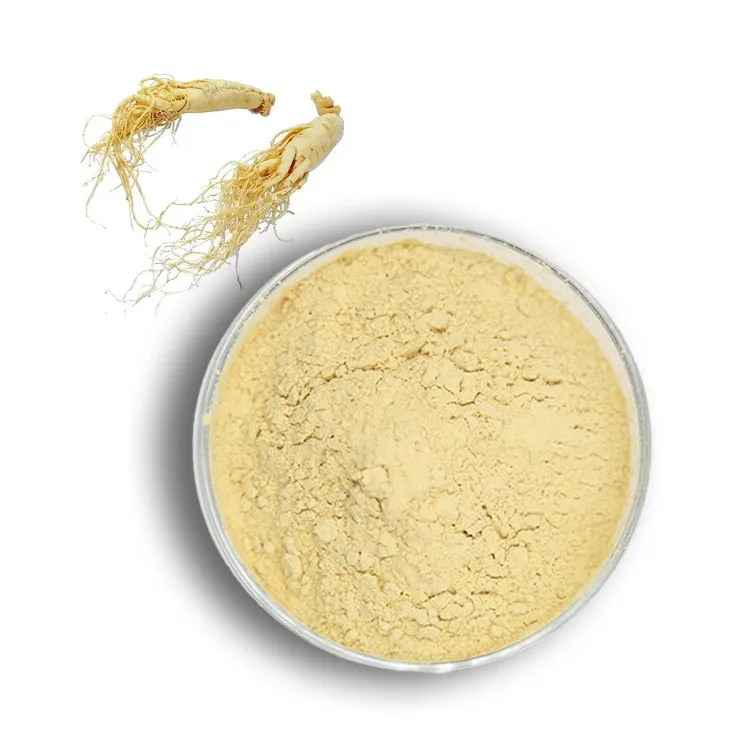- 0086-571-85302990
- sales@greenskybio.com
Organic supercritical CO₂ extraction of ginseng root extract.
2024-11-26

1. Introduction
The extraction of Ginseng Root Extract has long been a subject of great interest in the fields of medicine, cosmetics, and food supplements. Ginseng, a well - known and highly valued medicinal plant, is native to Asia and has been used in traditional medicine for thousands of years. It contains a variety of bioactive components, with ginsenosides being among the most important ones. These components are responsible for numerous health - promoting effects, such as anti - inflammatory, antioxidant, and immune - enhancing properties. Over the years, different extraction methods have been developed to isolate these valuable components from ginseng roots. However, the organic supercritical CO₂ extraction method has emerged as a particularly remarkable and advanced technique.

2. The Principle of Supercritical CO₂ Extraction
Supercritical CO₂ extraction is based on the unique properties of carbon dioxide (CO₂) near its critical point. The critical point of CO₂ is reached at a specific temperature and pressure (31.1°C and 73.8 bar). At this point, CO₂ exhibits properties that are intermediate between those of a gas and a liquid. It has a density similar to that of a liquid, which allows it to dissolve a wide range of substances like a solvent, while maintaining the diffusivity of a gas, enabling it to penetrate porous materials easily.
When CO₂ is in its supercritical state, it can be used to selectively extract certain components from a complex matrix such as ginseng roots. By adjusting the temperature and pressure conditions slightly above the critical point, the solubility of different components in the supercritical CO₂ can be manipulated. This enables the extraction of specific compounds, leaving behind unwanted substances in the raw material.

3. Advantages of Supercritical CO₂ Extraction for Ginseng Root Extract
3.1 Environmental - friendliness
One of the most significant advantages of supercritical CO₂ extraction is its environmental - friendliness. CO₂ is a natural component of the atmosphere, non - toxic, and non - flammable. After the extraction process, it can be easily removed from the extract by simply reducing the pressure, and then recycled for further use. This makes it a much more sustainable option compared to traditional organic solvents, which may be harmful to the environment and require complex and costly disposal procedures.
3.2 Preservation of Bioactivity
For ginseng root, which is a precious and delicate medicinal plant, maintaining the bioactivity of its components during extraction is crucial. Supercritical CO₂ extraction is a relatively mild process compared to some traditional extraction methods such as solvent extraction using harsh chemicals. It can effectively isolate valuable components like ginsenosides without causing significant damage to their bioactivity. This is because the extraction conditions can be carefully controlled to avoid excessive heat, pressure, or chemical exposure that could otherwise degrade the active ingredients.
3.3 High - selectivity
The supercritical CO₂ extraction process operates under specific temperature and pressure conditions near the critical point of CO₂. This allows for high - selectivity extraction. Different components in ginseng roots have different solubilities in supercritical CO₂ depending on the precise temperature and pressure. By optimizing these parameters, it is possible to selectively extract the desired components, such as ginsenosides, while minimizing the extraction of unwanted substances. As a result, a Ginseng Root Extract with high purity can be obtained.

4. The Extraction Process of Ginseng Root Extract Using Supercritical CO₂
The extraction of ginseng root extract using supercritical CO₂ typically involves several steps:
-
Preparation of raw materials: High - quality ginseng roots are carefully selected and cleaned. They are usually dried and ground into a suitable particle size to increase the surface area available for extraction.
-
Loading into the extraction vessel: The prepared ginseng root powder is loaded into the extraction vessel. The extraction vessel is designed to withstand the high pressures and temperatures required for supercritical CO₂ extraction.
-
Introduction of supercritical CO₂: CO₂ is pressurized and heated to its supercritical state and then introduced into the extraction vessel. The supercritical CO₂ flows through the ginseng root powder, dissolving the target components such as ginsenosides.
-
Separation of the extract: The mixture of supercritical CO₂ and dissolved components is then passed through a separator. By reducing the pressure in the separator, the solubility of the components in CO₂ decreases, and the extract is separated from the CO₂. The CO₂ can then be recycled back to the extraction process.
-
Collection and purification of the extract: The separated ginseng root extract is collected and may undergo further purification steps if necessary. This can include processes such as filtration to remove any remaining solid particles or impurities.

5. Health - promoting Effects of Ginseng Root Extract Obtained by Supercritical CO₂ Extraction
5.1 Anti - inflammatory Effects
The ginsenosides present in the ginseng root extract obtained by supercritical CO₂ extraction have been shown to possess anti - inflammatory properties. Inflammation is a natural response of the body to injury or infection, but chronic inflammation can lead to various diseases such as arthritis, cardiovascular diseases, and certain cancers. Ginsenosides can modulate the body's inflammatory response by interfering with the production of inflammatory mediators such as cytokines and prostaglandins.
5.2 Antioxidant Effects
Another important health - promoting effect of the ginseng root extract is its antioxidant activity. Antioxidants are substances that can neutralize free radicals, which are unstable molecules that can cause oxidative damage to cells and tissues. Oxidative damage has been implicated in the aging process and the development of many diseases, including neurodegenerative diseases, diabetes, and cancer. Ginsenosides and other components in the ginseng root extract act as antioxidants by donating electrons to free radicals, thereby stabilizing them and preventing them from causing further damage.
5.3 Immune - enhancing Effects
The ginseng root extract can also enhance the immune system. A strong immune system is essential for the body's defense against pathogens such as bacteria, viruses, and fungi. Ginsenosides can stimulate the production and activity of immune cells such as lymphocytes, macrophages, and natural killer cells. They can also regulate the immune response to ensure that it is appropriate and not over - reactive or under - reactive.

6. Applications of Ginseng Root Extract in Different Industries
6.1 Pharmaceutical Industry
In the pharmaceutical industry, ginseng root extract obtained by supercritical CO₂ extraction can be used as an ingredient in various medications. For example, it can be formulated into drugs for the treatment of inflammatory diseases, to boost the immune system in immunocompromised patients, or as an antioxidant supplement for the prevention of oxidative - related diseases.
6.2 Cosmetics Industry
The antioxidant and anti - inflammatory properties of ginseng root extract make it a valuable ingredient in the cosmetics industry. It can be added to skin care products such as creams, lotions, and serums to help protect the skin from oxidative stress, reduce inflammation, and improve skin health. It may also be used in hair care products to promote hair growth and strengthen hair follicles.
6.3 Food Supplement Industry
In the food supplement industry, ginseng root extract is a popular ingredient. It can be used to produce dietary supplements in the form of capsules, tablets, or powders. These supplements are often marketed for their health - promoting effects, such as increasing energy, improving mental focus, and enhancing overall well - being.
7. Conclusion
Organic supercritical CO₂ extraction of ginseng root extract is a highly advantageous technique. It offers environmental - friendliness, preservation of bioactivity, and high - selectivity extraction. The resulting ginseng root extract is rich in active ingredients such as ginsenosides, which have multiple health - promoting effects. This extract has wide applications in the pharmaceutical, cosmetics, and food supplement industries. As research continues to explore the full potential of ginseng root extract, supercritical CO₂ extraction is likely to play an increasingly important role in its production and utilization.
FAQ:
What are the main advantages of organic supercritical CO₂ extraction for ginseng root extract?
Organic supercritical CO₂ extraction for ginseng root extract has several main advantages. Firstly, CO₂ is non - toxic, making it a clean and environmentally - friendly method. It can be easily removed and recycled. Secondly, for the precious ginseng root, this method can effectively isolate valuable components while maintaining the bioactivity of these components. Also, it operates under specific temperature and pressure conditions near the critical point of CO₂, allowing for high - selectivity extraction, resulting in a high - purity extract rich in active ingredients like ginsenosides which have various health - promoting effects such as anti - inflammatory, antioxidant, and enhancing immunity.
What kind of active ingredients can be obtained from ginseng root extract by supercritical CO₂ extraction?
By supercritical CO₂ extraction of ginseng root, active ingredients such as ginsenosides can be obtained. Ginsenosides have various health - promoting effects including anti - inflammatory, antioxidant, and enhancing immunity.
How does the supercritical CO₂ extraction process maintain the bioactivity of ginseng root components?
The supercritical CO₂ extraction process operates under specific temperature and pressure conditions near the critical point of CO₂. This relatively gentle extraction condition can effectively isolate valuable components from ginseng root without causing much damage to their bioactivity.
Is the supercritical CO₂ extraction of ginseng root extract cost - effective?
While the initial setup for supercritical CO₂ extraction may require certain investment in equipment, in the long run, it can be cost - effective. Since CO₂ is non - toxic and can be recycled, the cost of raw materials is relatively low. Moreover, the high - selectivity extraction can lead to a high - quality product with rich active ingredients, which may have higher market value, thus potentially offsetting the initial investment cost.
What are the specific temperature and pressure conditions for supercritical CO₂ extraction of ginseng root extract?
The specific temperature and pressure conditions for supercritical CO₂ extraction of ginseng root extract are near the critical point of CO₂. However, the exact values may vary depending on different extraction systems and the desired quality of the extract. Generally, these conditions are carefully optimized to ensure high - selectivity extraction and to maintain the quality and bioactivity of the extract.
Related literature
- Supercritical Fluid Extraction of Ginseng: A Review"
- "Optimization of Supercritical CO₂ Extraction of Ginseng Active Compounds"
- "Bioactivity and Supercritical CO₂ Extraction of Ginseng Root Components"
- ▶ Hesperidin
- ▶ Citrus Bioflavonoids
- ▶ Plant Extract
- ▶ lycopene
- ▶ Diosmin
- ▶ Grape seed extract
- ▶ Sea buckthorn Juice Powder
- ▶ Fruit Juice Powder
- ▶ Hops Extract
- ▶ Artichoke Extract
- ▶ Mushroom extract
- ▶ Astaxanthin
- ▶ Green Tea Extract
- ▶ Curcumin
- ▶ Horse Chestnut Extract
- ▶ Other Product
- ▶ Boswellia Serrata Extract
- ▶ Resveratrol
- ▶ Marigold Extract
- ▶ Grape Leaf Extract
- ▶ New Product
- ▶ Aminolevulinic acid
- ▶ Cranberry Extract
- ▶ Red Yeast Rice
- ▶ Red Wine Extract
-
Andrographis Paniculata Extract Powder
2024-11-26
-
Epimedium extract powder
2024-11-26
-
Medicinal Marshmallow Extract
2024-11-26
-
Lemon Extract
2024-11-26
-
Mulberry Extract
2024-11-26
-
Calendula Extract
2024-11-26
-
Propolis Extract Powder
2024-11-26
-
Chia Seed Powder
2024-11-26
-
Dandelion Leaf Extract
2024-11-26
-
Hops Extract
2024-11-26





















